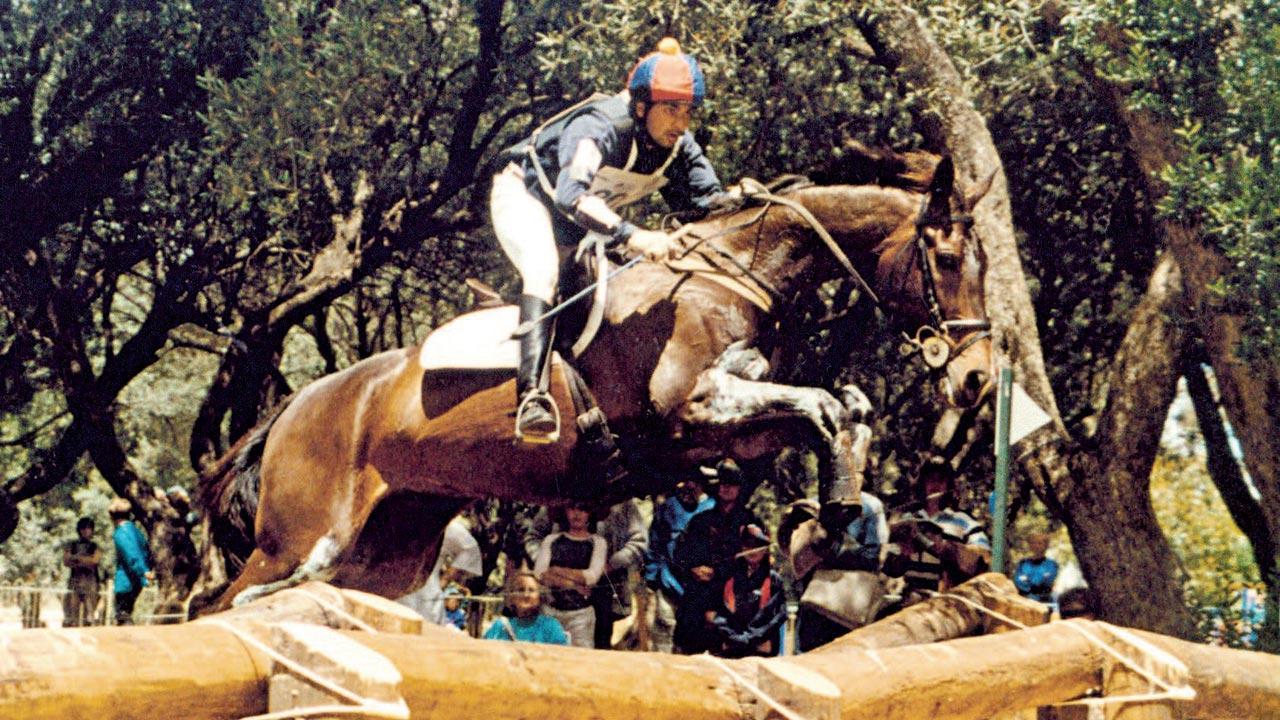Mumbai’s Imtiaz Anees, only the second Indian to represent India in equestrian sports at the Olympic Games in 2000, wishes to make his boutique stable a special place for riders to train and learn about horses

Anees with his Olympic star Spring Invader jumping over a massive Trakehner in the cross-country phase at the three-star Olympic games qualifier in Adelaide in 1999. Pics courtesy/Harpercollins India
Imtiaz Anees has always been drawn to horses. Even as a child of four, when he was still too young to ride, he grew close to a powerful grey stallion called Rajesh owned by his maternal grandfather Mohamed Kajiji who was the president of the Amateur Riders’ Club (ARC) in Mumbai. He groomed and hugged Rajesh, confiding all his childish joys and sorrows in the magnificent white-crested animal. “These were massive animals. I was little, not a big or strong boy, I was timid, I would say weak in many ways. But I just felt comfortable [with them] from day one, I could just go into a stable and brush the horse or hug it, and the horse had a rapport with me,” recalls Anees, during a conversation with mid-day. In spite of his many successes and experiences, Anees still regards his very first win on Rajesh as an early milestone in his life. “I remember it so clearly. I was a young boy. I can still see my family at the stands. They were scared. I weighed about 25 kilos and the horses were flying at full gallop. Anything could happen—a slip, a trip, I could even fall. And they allowed me to do it.”
ADVERTISEMENT
Anees’ new book Riding Free (HarperCollins India), is not simply about his moving Olympian journey, but also, he says, about his relationship with each horse along the way, those bonds crucial even to the formulation of this book. “When trying to recall the events in a chronological manner, I actually remembered my horses, and the stories and competitions around them then came back to me very quickly.”
Anees with his beloved white-crested grey stallion Rajesh with whom he won many early competitions
The dream to become a professional athlete took hold at a young age. “I was a little boy who only wanted to represent his country; I didn’t care in which sport. If I had met Carl Lewis, I may have become an athlete; if I’d met Mark Spitz, I may have become a swimmer—I was good at both these sports,” writes Anees in his book. But it was his training and mentorship under Diana Wilson, an accomplished international rider, and competitions at the national level that made that long-cherished wish seem realisable. The arduous training for it however taught him resilience. “You get up every morning, you have a routine and you stick with it. There wasn’t a day off, I was very regimental, that whole year was like clockwork,” says Anees of the months he spent training for the Olympics. “This book also tells parents and children that it’s about showing up.”
After 25 years in the US and another five in Australia, Anees decided to return to India to give back to a sport that had given him so much and started Seahorse Equestrian, a training centre with 16 horses, in Nargol, Gujarat. He speaks fondly of the school and his role as an educator, stressing on the individuality of athletes and how factors like the ride, the trainee’s mental capacity, and physical and mental readiness need to be carefully considered. At the same time, through the centre, he aims to help people understand horses. “My goal is to make Seahorse Equestrian a special place for riders of all levels to come, train and learn about horses. It’s not only about a riding lesson. It’s about learning what these horses are about—nutrition, management, physiotherapy, massage therapy. They are athletes; it is important to know how to look after these athletes.”
Since his young days when he was the only civilian competing in it, riding being an army-dominated sport, and the events being held in army cantonment areas, the sport has changed drastically. “[At the time], I was the lone ranger,” says Anees. While there are many civilian riders competing in events now, in India, the sport’s key requirement for growth is space. “It used to be an offshoot of the racing centres. So, equestrian was held where there was racing—in Mumbai, Pune, Calcutta, Delhi. Now, it’s gone to the Tier 2 cities and it’s important that it stays and grows there because they have the space,” he says. But while passionate about its growth in India, Anees is emphatic about its larger educative role. “It’s a lovely sport for every child to experience because an animal is involved. With other sports like cricket or football, once it’s over, you put your kit back and [you’re done]. But with horses, it doesn’t work like that. Whether you’ve had a good or a bad day, or even if you have fallen off, you still have to come back to the stable and look after that horse, bandage and feed it, make sure there’s enough water. It builds character.”
 Subscribe today by clicking the link and stay updated with the latest news!" Click here!
Subscribe today by clicking the link and stay updated with the latest news!" Click here!






